An Interview with Kevin Tschudi
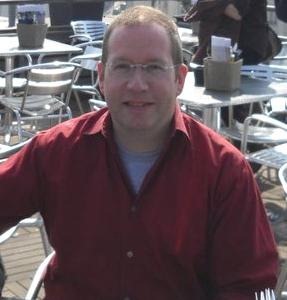
Picture courtesy Kevin Tschudi
One of the most famous TRS-80 companies was Alpha Products. If you called technical support at Alpha Products after 1984, you probably spoke to Kevin Tschudi. While working there from 1981 to 1991, he wrote the VS-100 Talker software and Newclock-80 drivers and co-designed the A-Bus system.
In this interview, conducted in August 2011, he talks about his experiences at Alpha Products.
Q: Tell a little bit about yourself. How did you get started with computers and the TRS-80?
A: I’d like to say “It was a dark and stormy night,” but it’s really pretty boring. I was 15. My dad, who often was an early adopter of electronic gadgets, decided to buy a TRS-80 Model I for the family. I liked solving problems with programming, so taught myself by writing a small application that helped my dad project cash flows at his work. I just did it for fun.
Q: How did you become involved with Alpha Products?
A: I was looking through 80 Micro one day in ‘81, and happened to notice the ad for Alpha Products. It turns out that the world headquarters was in a basement about 10 houses up the street from me – which in Queens, NY is about 200 feet away.
At that time, Bob Rosen was a salesman at the local Radio Shack. I’ve heard that Bob was the first purchaser of a TRS-80 – and calls himself the first PC user. Bob would later start a popular BBS and found Spectrum Projects, which was a big player in Color Computer software and accessories. In ‘81, he was the guy at the Radio Shack who I would talk computers with. Bob introduced me to John Monin, the owner of Alpha. On finding that I had some experience writing software, John asked me to work on some of his projects.
Alpha was in the midst of the joystick boom. There were about 8 people working in a very cramped basement. I’d be surprised if it was more than 800 sq. ft. Along one wall was the assembly line – three or four underage neighborhood kids, working for below minimum wage, soldering and assembling joysticks and the other products. Nestled under the stairs were Karen and Roseanne who took orders and handled the billing and filing. The workbench at the back near the stairs doubled as the shipping station. In the front, next to the washer and dryer, Jack handled much of the marketing functions.
One of the unique things about Alpha was that virtually everything was done in-house. As an example, for the first few years, all the circuit boards were printed, cut, and drilled in-house at the workbench. The cables were all assembled by hand. Even the advertising was done in house – only the raw typesetting was done at the local paper, but even that was edited with a razor and wax. The games were bought from others, but the design of the hardware was all done in the same basement alongside the production. The Green Screens were made on site – a toaster oven softened the plastic, a Model I monitor tube was pressed into the plastic to form the shape. Once cooled, the screens were hand trimmed and bagged.
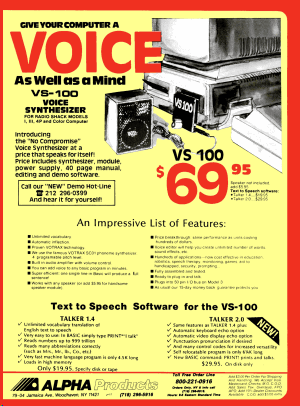
Alpha Products VS-100 advertisement from 1985
Q: What products did you work on at Alpha Products?
A: The first project I worked on was rather fascinating, but behind the scenes. The order taking and fulfillment paperwork were getting a bit out of control. We put together a solution with Model I’s, label printers, and some homebrew software. I wrote the software that Karen and Roseanne used to take the orders. The screen had the expected areas for items ordered, shipping address, and payment details – and it didn’t take long before that layout was permanently burned into the order taking monitors.
It seems funny now, but one of the biggest challenges was that the TRS-80 BASIC lacked type-ahead. If the software was busy when the operator typed, the keystroke was lost. My introduction to assembler was in writing a background routine that would catch letters as they were typed, and feed them to the program as fast as it could handle them.
The genius of the system (and I give all the credit to John for this) was that he managed to design all the workflow to fit on 1.5" x 3.5" mailing labels. My challenge was to make his designs fit – varying the font size and the pitch in tiny increments so as to fit all the permutations in the space available. Depending on the order details, 7 to 10 labels would print. One gave instructions to the packer. One was slapped onto a card and went into the customer file. Another was put onto a piece of paper and became the customer’s receipt. If the order was COD, one type of label came out for the UPS COD form; if the order was by credit card, a different label went on to the credit card deposit slip. Another label went into the UPS tracking book, and of course one label was the mailing label on the package. It was quirky and it wasn’t particularly attractive, but it was amazingly cheap and efficient.
I later wrote the Talker software and Newclock-80 drivers, then graduated from college and started working at Alpha full time. At that point, I got into the hardware side of things and co-designed the A-Bus system, which kept us busy for a few years.
Q: The Talker software for the VS-100 voice synthesizer was remarkably advanced for its time. What was your inspiration for the product?
A: The fundamentals of it were pretty simple. BYTE had published an article with the text to speech algorithm – excerpting from some Naval Research Lab work that had been done. I tracked down the original research, and that provided the framework of the text to speech rules. The rules boiled down to looking at the letter in the word, and depending on the letters around it, determining which phoneme to use. For example, K followed by N produces nothing – if K wasn’t followed by N, use the phoneme code 19.
We only tweaked a few rules. We found that most people tried their own name first, and the rules (based on English pronunciation) did very poorly with names from other ethnicities. I did bury a rule that helped it pronounce my name correctly. We also found that many people tried to make the device curse, so we took two choice words and had them pronounced “bleep.” Most people got the joke and quickly found that if you misspelled those words, the VS-100 cursed quite nicely. We did get one angry letter from a customer that was offended by our censoring.
By that time, I was familiar with James Farvour’s Microsoft BASIC Decoded – that led to the discovery that the ROM BASIC had some hooks that could be hijacked. In particular, the PRINT command had a hook for the Disk BASIC PRINT# command. So we redirected that hook. If it was a star, we pronounced the text that followed (which the ROM had conveniently parsed). If it wasn’t a star, we just sent it along its way.
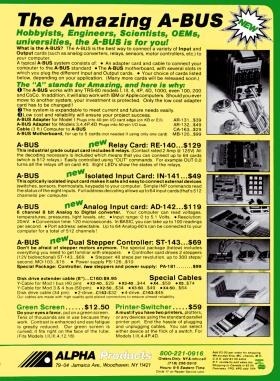
Alpha Products A-Bus advertisement from 1984
Q: The A-Bus was an intriguing product line addressing a market not really targeted today. What were the design goals for the A-Bus? Do you think such a product would still be of interest to customers today?
A: Before my time, John had developed the Interfacer-80 and the Analog-80 devices to work off the Model I bus. Those products were never best-sellers, but they were consistently in demand and profitable. We wanted to produce more products like these, but the biggest challenge was the increasing incompatibility of the various expansion busses – the Model III expansion bus differed from the Model I bus, which was totally different from the Color Computer bus, and so on.
Behind the scenes, Alpha had a sister company, Colorware, which was supporting the Color Computer, and another sister company, Zebra Systems, which was supporting the Timex Sinclair ZX81, so we were thinking more broadly than just the TRS-80 market.
So the first goal was to come up with a system that could be compatible with many of the computers then out there, and be able to roll the line out to new computers as they were released. We could also sell into niche markets for data acquisition and control boards. For example, the RS Color Computer sold well, but the number of customers that wanted I/O boards was limited. We couldn’t justify designing a line of CoCo-specific I/O products, but we could justify designing, producing, and stocking a CoCo adapter – because it would drive incremental sales of the other A-Bus cards.
We could have done this with an existing bus, but the second design goal was to keep manufacturing costs down. The A-Bus was deliberately one-sided: circuit boards with copper on one side were significantly cheaper than two sided boards (and were easier to repair in production). The sequence of pins was also organized to simplify the layout of the individual cards.
Had PCs remained a Babel of incompatible busses, the A-Bus might have continued to grow, but our competitive advantage started to wane as the world standardized on the IBM PC.
Q: A 1990 TRS-80 magazine quoted you as saying Alpha Products still sold TRS-80 hardware, including the VS-100. Why do you think Alpha Products was able to sell products for multiple platforms so much longer than other companies?
A: By 1990, we weren’t selling much TRS-80 product. We still had a little inventory and would sell it as inquiries came in, but there wasn’t much demand. A-Bus for the TRS-80 continued to move occasionally as customers repurposed their computers into controllers. By that time the majority of the business was coming from IBM PC users.
Q: Do you know what happened to Alpha Products eventually? The last reference I have found was in 1998.
A: John, the founder of Alpha Products, sold out completely in the fall of 1989. Perhaps the new owners were unlucky, perhaps they bit off more than they could handle, but the company’s finances deteriorated rapidly. I held on for another two years, but abandoned ship in 1991. The new owners were trying diverse product lines, including dealing in baseball cards and telephone cards, and were announcing affiliations with a number of different companies in the data I/O space. My understanding is that subsequently a reverse acquisition was done of a listed penny stock, which emerged as DCI Telecommunications. DCI later declared bankruptcy and the principals were prosecuted by the SEC for accounting fraud. The remnants of Alpha were lost in that mess. Not a particularly happy ending for Alpha Products.
Q: What have you been doing since your days at Alpha Products?
A: I moved back into software development, eventually ending up as a systems analyst at Starwood Hotels and Resorts, where I’ve been for the past eight years.
I spent ten years at Alpha, and so it’s definitely a part of who I am. I forget how I stumbled across your site, but it was so wonderful to see all the old stuff back to life on the web. The pictures, the products, the names – it’s a great resource, and I thank you for putting it there.
My thanks to Kevin Tschudi for his participation in this interview.
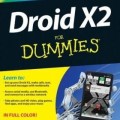
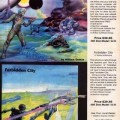

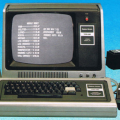










Dusty Miller says:
A most interesting article, Matthew. Thank you both.
Mark McDougall says:
Very interesting read, especially to hear about the reality of companies like Alpha, Colorware & Spectrum Projects! As a kid when you see the advertisements in magazines like 80 Micro, you imagine large, shiny office buildings!
Don’t suppose there are any surviving photos of the basement???
David Sutherland says:
Thank you Matthew and Kevin.
John monin says:
what a blast!
Reliving this wonderful adventure
Thanks a million to Kevin. His interview brought a lot of fond memories.
Hey Kevin, if you read this, email me
Thanks also to the people behind this great site.
John ( founder with Kevin of Alpha Product )